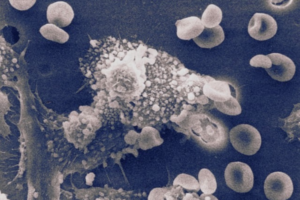by

By silencing the molecular pathway that prevents macrophages from attacking our own cells, Penn Engineers have manipulated these white blood cells to eliminate solid tumors.
Cancer remains one of the leading causes of death in the U.S. at over 600,000 deaths per year. Cancers that form solid tumors such as in the breast, brain or skin are particularly hard to treat. Surgery is typically the first line of defense for patients fighting solid tumors. But surgery may not remove all cancerous cells, and leftover cells can mutate and spread throughout the body. A more targeted and wholistic treatment could replace the blunt approach of surgery with one that eliminates cancer from the inside using our own cells.
Dennis Discher, Robert D. Bent Professor in Chemical and Biomolecular Engineering, Bioengineering, and Mechanical Engineering and Applied Mechanics, and postdoctoral fellow, Larry Dooling, provide a new approach in targeted therapies for solid tumor cancers in their study, published in Nature Biomedical Engineering. Their therapy not only eliminates cancerous cells, but teaches the immune system to recognize and kill them in the future.
“Due to a solid tumor’s physical properties, it is challenging to design molecules that can enter these masses,” says Discher. “Instead of creating a new molecule to do the job, we propose using cells that ‘eat’ invaders – macrophages.”
Macrophages, a type of white blood cell, immediately engulf and destroy – phagocytize – invaders such as bacteria, viruses, and even implants to remove them from the body. A macrophage’s innate immune response teaches our bodies to remember and attack invading cells in the future. This learned immunity is essential to creating a kind of cancer vaccine.
But, a macrophage can’t attack what it can’t see.
“Macrophages recognize cancer cells as part of the body, not invaders,” says Dooling. “To allow these white blood cells to see and attack cancer cells, we had to investigate the molecular pathway that controls cell-to-cell communication. Turning off this pathway – a checkpoint interaction between a protein called SIRPa on the macrophage and the CD47 protein found on all ‘self’ cells – was the key to creating this therapy.”
Read the full story in Penn Engineering Today.
Multiple members in the biophysical engineering lab lead by Dennis Discher, including co-lead author and postdoctoral fellow and Penn Bioengineering alumnus Jason Andrechak and Bioengineering Ph.D. student Brandon Hayes, contributed to this study. The research was funded by grants from the National Heart, Lung, and Blood Institute and the National Cancer Institute, including the Physical Sciences Oncology Network, of the US National Institutes of Health.
